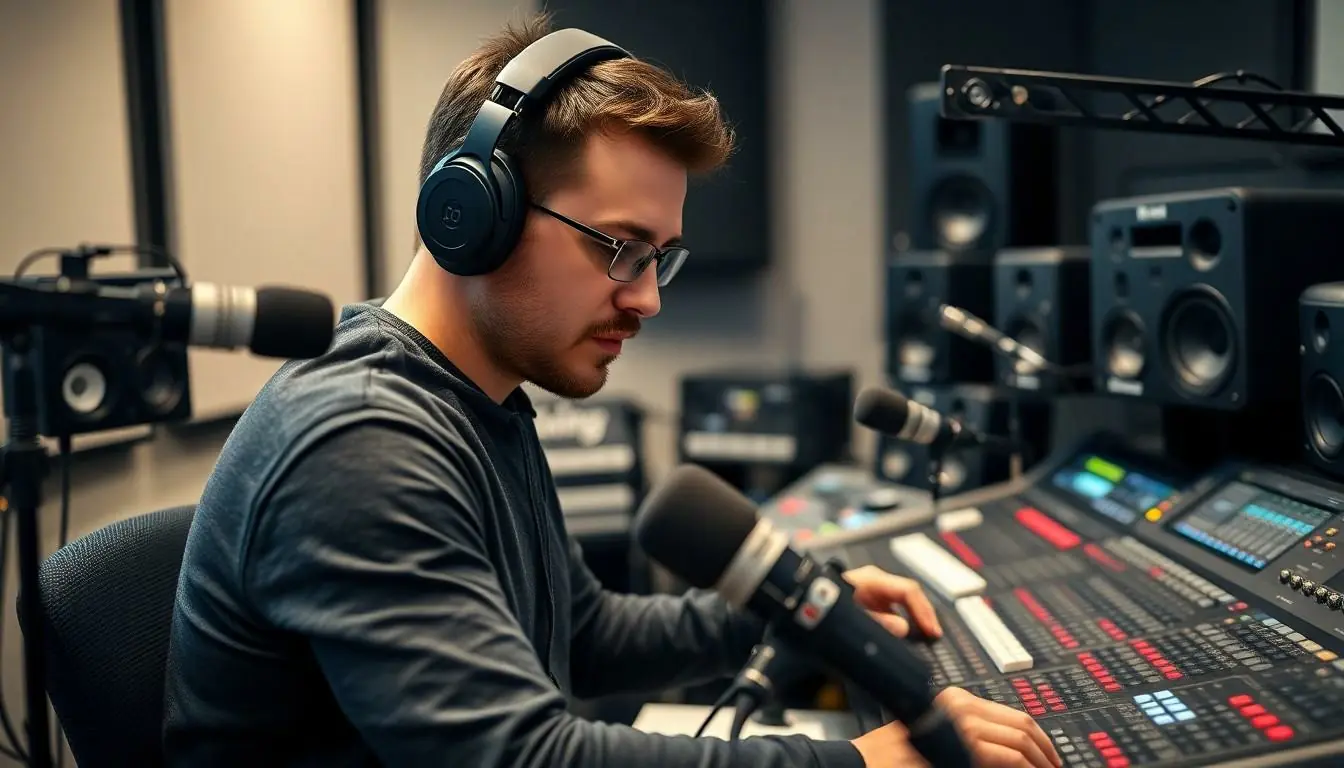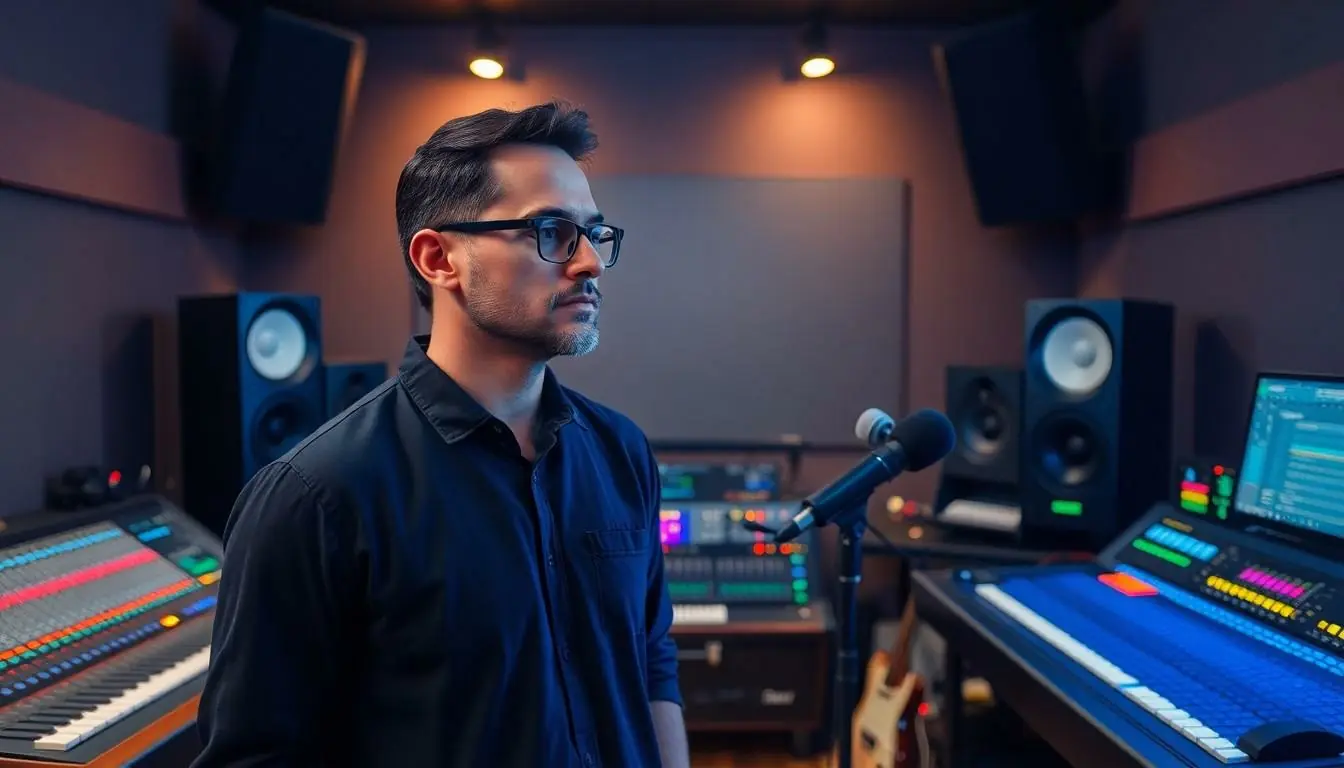Table of Contents
ToggleIn a world where sound can make or break a moment, pro audio technology steps in like a superhero with a microphone. Whether it’s a live concert that gets your heart racing or a podcast that feels like a chat with an old friend, the right gear transforms ordinary audio into an unforgettable experience. It’s not just about turning up the volume; it’s about capturing every nuance and making listeners feel like they’re right there in the action.
Overview of Pro Audio Technology
Pro audio technology plays a crucial role in sound quality across various applications. Essential tools like microphones, mixers, and speakers form the foundation of any professional audio system. Microphones capture sound, while mixers allow for precise adjustments and effects. Speakers project that sound, making it accessible to audiences.
Audio interfaces serve as connectors between instruments and computers, enabling digital recording and editing. High-fidelity headphones provide accurate sound reproduction for monitoring, ensuring clarity during production. Each component works together to create a cohesive experience, tailored to the specific environment.
The use of digital audio workstations (DAWs) has revolutionized recording and production processes. These software solutions enable artists and engineers to manipulate audio with precision, applying effects and editing tracks seamlessly. Cloud-based platforms also facilitate collaboration between remote teams, streamlining workflows.
Investing in quality pro audio technology enhances creativity and productivity. Brands like Neumann and Shure offer industry-standard microphones known for their durability and performance. Yamaha and Allen & Heath produce reputable mixers that boast advanced features for live sound applications.
Consistency in design and implementation also drives sound clarity. When equipment is well-matched and systems are properly calibrated, the end result is professional-grade audio. Professionals rely on accurate sound reproduction to ensure that every nuance and detail translates effectively to the audience.
Finally, it’s important to stay updated with emerging technologies. Innovations like immersive audio formats and wireless transmission systems continue to shape the landscape of professional audio. Embracing these advancements keeps audio production relevant and competitive.
Key Components of Pro Audio Technology

Pro audio technology relies on several key components that ensure optimal sound quality and performance. Understanding each component aids in selecting the right gear for specific audio needs.
Microphones
Microphones capture sound and convert it into an electrical signal. Dynamic microphones excel in high sound pressure environments, making them ideal for live performances. Condenser microphones, on the other hand, capture subtle nuances and are often preferred for studio recordings. Brands like Neumann and Shure create industry-standard microphones that professionals trust. Each microphone type plays a unique role in audio production, influencing the overall quality of recordings.
Mixing Consoles
Mixing consoles serve as the control hub for audio signals. These devices combine multiple audio sources, allowing for precise adjustments. Both analog and digital mixing consoles are available, each offering distinct benefits. Digital mixers often provide advanced features like multi-track recording capabilities and built-in effects. Yamaha and Allen & Heath mixers are renowned for their reliability and versatility, making them popular choices among audio professionals. A well-equipped mixing console can enhance sound quality and streamline the recording process.
Audio Interfaces
Audio interfaces facilitate the connection between instruments and digital systems for recording. They convert analog signals into digital data that computers can process. Quality audio interfaces ensure low latency and high-resolution audio playback. Popular models often feature multiple input and output options, catering to various audio needs. Investing in a reliable audio interface greatly improves the efficiency of the recording workflow and enhances sound fidelity. Top brands frequently produce models that meet the demands of both professionals and enthusiasts alike.
Emerging Trends in Pro Audio Technology
Pro audio technology continuously evolves, reflecting advancements in digital tools and consumer demands. Current trends focus on digital signal processing and wireless technologies, which enhance audio production and delivery.
Digital Signal Processing
Digital signal processing (DSP) plays a key role in modern audio systems. DSP algorithms manipulate audio signals, allowing for real-time effects, equalization, and noise reduction. Enhanced flexibility, these algorithms enable sound engineers to adapt audio characteristics to specific environments, ensuring optimal playback. For instance, adaptive EQs automatically adjust frequencies based on feedback from the room. Innovations in DSP also include spatial audio formats that create immersive listening experiences, making sound seem to envelop the audience. As technology advances, further improvements in latency and processing power will support even more complex audio applications.
Wireless Technologies
Wireless technologies have transformed the pro audio landscape. By eliminating cables, these systems enhance mobility and convenience during performances and recordings. Digital wireless microphones and in-ear monitoring systems deliver clear sound without interference, allowing artists to move freely on stage. Improved range and battery life are notable advancements in this field. Recent systems utilize advanced encryption to protect signals, ensuring high-quality transmissions without compromising security. The trend toward wireless technology continues as audio professionals seek solutions that streamline setups and enhance performance flexibility.
Applications of Pro Audio Technology
Pro audio technology plays a crucial role in various sectors, enhancing sound quality and user experiences.
Live Sound
Live sound systems ensure optimal audio quality during events, making concerts and performances memorable. Concert venues rely on powerful speakers, mixers, and microphones to deliver dynamic sound. These components work together to create a balanced auditory experience. Sound engineers utilize advanced mixing consoles to control audio levels, ensuring clarity for both performers and audiences. Wireless microphones enhance mobility and eliminate cable clutter, facilitating seamless interactions on stage. The right gear not only improves sound fidelity but also elevates the overall atmosphere during live events.
Studio Recording
Studio recording focuses on capturing audio with precision. Professional studios utilize high-quality microphones and audio interfaces to maintain sound integrity. Dynamic and condenser microphones serve different purposes, each excelling in specific recording environments. Mixing consoles play a vital role, allowing sound engineers to blend tracks for a polished final product. Digital audio workstations (DAWs) enable detailed audio manipulation, making it easier to edit and mix recordings. With superior equipment, artists can achieve exceptional results that showcase their talent and creativity.
Broadcast
Broadcast applications demand reliability and clarity in audio reproduction. Television and radio stations utilize professional audio equipment to ensure that broadcasts reach listeners effectively. The integration of digital signal processing enhances sound quality, providing clear transmissions over various formats. Wireless technologies facilitate mobility for presenters and reporters, allowing them to capture audio from various locations. Streaming platforms also benefit from improved audio setups that enhance listener experiences. High-fidelity equipment in broadcasting maintains sound quality, ensuring consistent performance across different mediums.
Pro audio technology plays a vital role in shaping sound experiences across various platforms. By investing in high-quality equipment and staying informed about emerging trends, audio professionals can significantly enhance their craft. The right microphones, mixers, and audio interfaces not only ensure superior sound quality but also foster creativity and collaboration.
As the industry evolves with advancements in digital signal processing and wireless technologies, it’s essential for audio experts to adapt and innovate. Embracing these developments will not only improve performance but also elevate the overall listening experience for audiences. Ultimately, a commitment to quality and continuous learning will keep professionals at the forefront of the ever-changing pro audio landscape.






